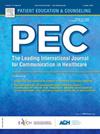建立一个网站,帮助55岁的妇女 + 将风险纳入乳腺癌筛查和预防药物的决策中
IF 2.9
2区 医学
Q2 PUBLIC, ENVIRONMENTAL & OCCUPATIONAL HEALTH
引用次数: 0
摘要
目的指南建议妇女在决定乳腺癌筛查(例如,间隔时间,何时停止)和预防药物时考虑她们患乳腺癌的风险和预期寿命。我们之前开发了一个竞争风险模型来预测妇女10年乳腺癌风险和非乳腺癌死亡>; 55年,以支持决策。在这里,我们的目标是开发一个决策辅助(DA)网站,结合我们的模型的风险估计。方法根据国际标准,利用免费的R软件包Shiny对数据数据进行设计。我们包括了一个风险评估页面,风险评估,以及乳腺癌筛查和预防药物的决策支持。我们招募了国家专家、波士顿地区初级保健医生(pcp)和55岁无乳腺癌病史的女性患者>; ,通过问卷调查或个人访谈的方式对DA提供反馈。我们使用主题分析来确定参与者开放式评论中的主题,直到主题饱和。研究问卷评估了数据处理的有用性和易用性。结果84例符合条件的患者中有45例(53.6 %)参与了研究。他们的平均年龄为65.9岁(SD为7.9),非西班牙裔白人31人(68.9% %),大学毕业31人(68.9% %)。在联系的52位专家/ pcp中,有30位参与。参与者认为DA有帮助(35/44例患者[79.5 %]和28/29例[96.6 %]专家/ pcp),易于使用(39/45例患者[86.7 %]和28/29例pcp /专家,[96.6 %])。他们形容DA“信息丰富”,喜欢“量身定制的风险信息”。他们建议进行修改,以简化决策支持,并使决策支持更加个性化。我们反复修改网站。我们无法使用免费的R应用程序编写一些建议的更改。结论我们使用免费软件为女性开发了一个信息丰富、易于使用的乳腺癌筛查和预防用药DA网站(https://bcrisk55plus.shinyapps.io/risktool/) >; 55。接下来,我们将使用HTML代码对网站进行编程,并对其效果进行前瞻性测试。实践意义我们预计使用DA将有助于妇女>; 55进行乳腺癌筛查和预防决策。本文章由计算机程序翻译,如有差异,请以英文原文为准。
Developing a website to help women aged 55 + incorporate risk in decision-making about breast cancer screening and prevention medications
Objectives
Guidelines recommend women consider their breast cancer risk and life expectancy when deciding on breast cancer screening (e.g., intervals, when to stop) and prevention medication. We previously developed a competing-risk model to predict 10-year breast cancer risk and non-breast cancer death in women > 55 years to support decision-making. Here, we aimed to develop a decision aid (DA) website incorporating our model’s risk estimates.
Methods
We designed the DA based on international standards using the free R package Shiny. We included a risk-assessment page, risk estimates, and decision support on breast cancer screening and prevention medications. We recruited national experts, Boston-area primary care practitioners (PCPs), and female patients > 55 years without breast cancer history to provide feedback on the DA via questionnaire or personal interview. We used thematic analysis to identify themes in participants’ open-ended comments until reaching thematic saturation. Study questionnaires assessed DA helpfulness and ease-of-use.
Results
Forty-five (53.6 %) of 84 eligible patients approached participated. Their mean age was 65.9 years (SD 7.9), 31 (68.9 %) were non-Hispanic White, and 31 (68.9 %) graduated college. Of 52 experts/PCPs contacted, 30 participated. Participants found the DA helpful (35/44 patients [79.5 %] and 28/29 [96.6 %] experts/PCPs) and easy-to-use (39/45 patients [86.7 %] and 28/29 PCPs/experts, [96.6 %]). They described the DA as “informative” and liked the “tailored-risk information.” They suggested changes to simplify the DA and to better individualize the decision-support. We iteratively revised the website. We could not program some recommended changes using the free R application.
Conclusions
We developed an informative and easy-to-use breast cancer screening and prevention medication DA website (https://bcrisk55plus.shinyapps.io/risktool/) for women > 55 using free software. Next, we will program the website using HTML code and test its effects prospectively.
Practice Implications
We anticipate that use of the DA will help women > 55 with breast cancer screening and prevention decisions.
求助全文
通过发布文献求助,成功后即可免费获取论文全文。
去求助
来源期刊

Patient Education and Counseling
医学-公共卫生、环境卫生与职业卫生
CiteScore
5.60
自引率
11.40%
发文量
384
审稿时长
46 days
期刊介绍:
Patient Education and Counseling is an interdisciplinary, international journal for patient education and health promotion researchers, managers and clinicians. The journal seeks to explore and elucidate the educational, counseling and communication models in health care. Its aim is to provide a forum for fundamental as well as applied research, and to promote the study of organizational issues involved with the delivery of patient education, counseling, health promotion services and training models in improving communication between providers and patients.
 求助内容:
求助内容: 应助结果提醒方式:
应助结果提醒方式:


